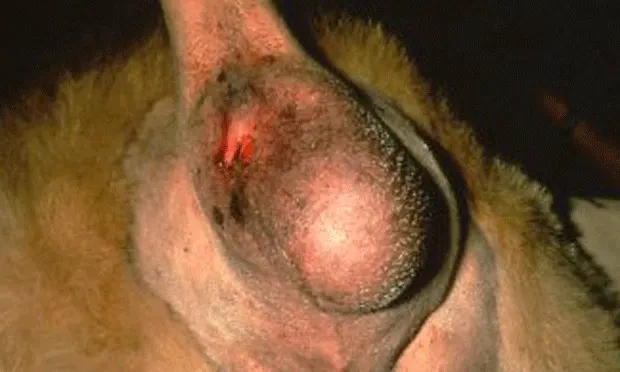Perineal Hernias

Perineal hernias result from progressive weakness and ultimate unilateral or bilateral failure of the pelvic diaphragm (ie, levator ani and coccygeal muscles).
These hernias can cause defecation strain when fecal matter accumulates in the rectal portion and is displaced through the pelvic diaphragmatic defect. A bulge becomes visible lateral to the tail base.
Related Article: Repairing Diaphragmatic Hernia
Bladder displacement can also result in urinary tract obstruction. Several reports suggest that straining mediated by prostatomegaly may contribute to perineal hernia development (see Suggested Reading), but this is not yet proven.
DiagnosesPerineal hernias occur most frequently in intact male dogs, although cases have been reported in castrated dogs. Female dogs also can develop perineal hernias. However, the reasons for sex predilection of this condition are unclear, as the role of reproductive hormones in the loss of pelvic diaphragm function or integrity is not conclusive.

Definitive diagnosis of perineal hernias is obtained by digital rectal examination. Weakness or partial herniation identified by digital rectal examination suggests that a perineal hernia may subsequently occur.
TreatmentTreatment depends on the severity of clinical signs. However, effective long-term treatment requires surgery—typically transposition of the internal obturator muscle. For intact dogs, castration with prostatomegaly is advised, but there is no proof that castration decreases the potential for surgical repair failure.

Synthetic mesh can be used in place of the obturator muscle if the hernia recurs, and a success rate of 85% to 90% has been reported for this procedure (see Suggested Reading). Although a fistula may develop if a suture is inadvertently passed through the anal sac, this can be resolved by passing forceps through and grasping the suture for removal. In my experience, this has not resulted in failure of the surgical repair.
Perineal Hernias • Dale E. Bjorling
Suggested Reading
Androgen receptors in the pelvic diaphragm muscles of dogs with and without perineal hernia. Mann FA, Nonneman DJ, Pope ER, et al. Am J Vet Res 56:134-139, 1995.Evaluation of internal obturator muscle transposition in treatment of perineal hernia in dogs. Hardie EM, Kolata RJ, Early TD, et al. Vet Surg 12:69, 1983.Perineal hernia repair in the dog by transposition of the internal obturator muscle. II. Complications and results in 100 patients. Sjollema BE, van Sluijs FJ. Vet Q 11:18-23, 1989.Perineal hernia with bladder retroflexion in a female cocker spaniel. Niles JD, Williams JM. J Small Anim Pract 40:92-94, 1999.Perineal herniorrhaphy: Perioperative data from 100 dogs. Hosgood G, Hedlund CS, Pechman RD, Dean PW. JAAHA 31:131-342, 1995.Use of polypropylene mesh in addition to internal obturator transposition: A review of 59 cases (2000-2004). Szabo S, Wilkens B, Radasch RM. JAAHA 43:136-142, 2007.